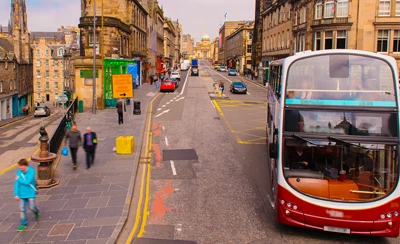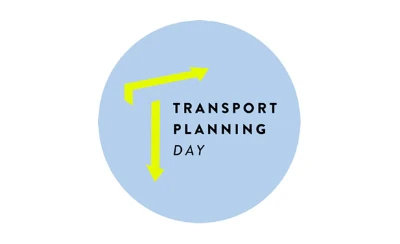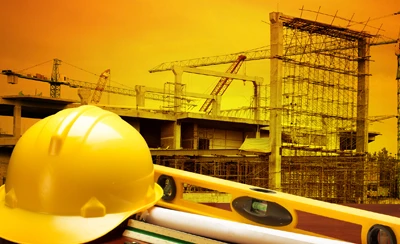TP Day Campaign 2021 - Transport decarbonisation and accessibility: What does COP26 mean for transport planners and an inclusive, accessible transport network?
COP26 is now underway in Glasgow, until the 12th November. But what is a ‘COP’, and what does it really mean for transport planners and an inclusive, accessible transport network? In my view, while COP26 is important in the global approach on climate change, whatever the outcome, transport planners can look locally now to make tangible actions to address both climate change and inaccessibility through both adaptation and mitigation.
Note: the term ‘walking and cycling’ includes trips made by wheelchair, other forms of active mobility such as rollerblading and scooting, and all forms of cycling including adapted and accessible cycles and e-bikes.
Introduction
The impacts of anthropogenic climate change are already being felt, and will continue to worsen unless we take drastic action to cut our emissions in the next decade, and limit global warming to within 1.5°C [i]. It feels (at least from within the host country) like a lot of hope is being placed on COP26. A specific combination of events means this one feels vitally important. It is the first COP taking place since the pandemic, the first of the decade, and comes after over a year of extreme weather events, this time felt in the global North as well - a wakeup call for some.
We know human activity must change if we are to avoid the worst effects of climate change, including our travel behaviours. Yet the transport system is still far from being wholly inclusive and fully accessible to all, making it impossible for those changes to happen. Developing an inclusive and accessible transport network is inseparable from successfully addressing climate change, both in cutting transport emissions and in preparing for – and adapting to – the inevitable impacts of climate change. Transport is vital to any global agreement on tackling climate change and will be a key part of COP26. Ultimately however, whatever is agreed at that international level, transport planners will still need to act on a subnational level to address the challenges of climate change and inaccessibility. This action to address both challenges must also consider the two key strands of climate action: adaptation and mitigation.
The 26th Conference of the Parties (COP26)
First, some context. Established in 1995, COPs are events where leaders from around the world come together to make decisions on the implementation of the United Nations Framework Convention on Climate Change (UNFCCC), and build on approaches adopted at previous COPs[ii]. Climate action can broadly be divided into two key tranches: Mitigation (action to reduce emissions to minimise the impacts of global warming) and adaptation (actions to adapt to the impacts of global warming that are already unavoidable, from ways of life to infrastructure).
While some critique the COPs as being ineffective, many see them as important in setting an international tone that can offer hope; inspiring and uniting action towards tackling climate change. I can see both sides of this debate and think they can be both. Either way, however, they must be complimented by sub-national action[iii].
COP / Transport: Where does transport fit into COPs currently?
I find the idea of a COP somewhat nebulous because it will comprise so many meetings and events at so many different levels, and could result in a range of outcomes even just at the leadership level. As such, it can feel hard to work out exactly how transport fits in and what actual impact COP26 will have on transport day-to-day in the UK. Exploring the COP26 and UNFCCC websites, transport primarily features as aviation, shipping, and technology (often focusing on international technology transfer and the promise of electric vehicles). The prominence of aviation and shipping makes sense given their expressly international nature. However, the COP26 website’s transport page [iv] is disappointing - it has only one section entitled ‘Accelerating the transition to zero emission vehicles’. Low-carbon sustainable transport is so much more than that!
As part of the Paris Agreement from COP21, countries produced Nationally Determined Contributions (NDCs), which contain their targets and action plans on tackling climate change – note, these are self-decided, non-legally-binding, and many, even if they were kept to, are not aligned with a 1.5 or 2°C pathway[v]. The UK’s 2020 NDC[vi] puts transport with energy and points to the transport decarbonisation plan[vii] for the detailed strategy on transport. In this plan, the UK government does recognise the broader picture of sustainable transport beyond simply electrification.
The Transport Planning Society (TPS) has recently published its full response to the transport decarbonisation plan as we approach COP26 [viii]. Our response is framed through the recommendations of our comprehensive “State of the Nations: Transport planning for a sustainable future”[ix], and generally welcomes this strategy while making further recommendations in light of this plan and the most recent IPCC report [x].
Where does inclusivity and accessibility fit into this?
Transport planners have to make sustainable choices easy and inclusive: that means affordable and accessible. Yet there are many barriers to sustainable travel options – just look at inaccessible pavements or the Reclaim These Streets movement[xi], demonstrating that walking is not always straightforward or possible. Behaviour won’t change in the ways it must if the transport system continues to make the more sustainable choice harder.
As Pedro Homem de Gouveia raised at the TPS’ recent ‘Sustainability versus inclusion: squaring the circle' event, it is a complex puzzle; we can’t just focus on fixing one section, we have to take a holistic view and try to fix all the issues with our solutions. There is going to be a shift in travel practices and projects delivered to decarbonise transport; rather than ignoring accessibility in this process, transport planners must deliver projects that solve both environmental and accessibility issues at the same.
So, what do we want from COP26 in terms of transport? Do we need anything?
For what it’s worth, I hope that at COP26, we go beyond NDCs, with countries making binding agreements and plans for mitigation and adaptation. I would also like to see agreement reached about how to ensure international shipping and aviation emissions are meaningfully counted, as well as ambitious targets. Looking further ahead, I would also like to see the narrative around decarbonising transport go beyond technology and acknowledge the role of good old active travel, even if it’s not something that would necessarily come under a COP agreement.
Ultimately though, regardless of how strong international cooperation is, it won't actually have much direct or immediate impact on local transport planning for active and sustainable modes here in the UK. We already have the government’s plan on decarbonising transport[xii] and Net-zero strategy [xiii] that provide a more detailed plan on how the UK government will support decarbonisation (as previously mentioned, the TPS has published its full response, detailing praise and recommendations). On this front, however, we do await the publication of the further strategies and guides that have been promised in the decarbonisation plan, and that I hope support the bond between environmental sustainability and inclusivity. We will need to see how things shake out during and after COP in the UK in terms of targets, policies and funding commitments.
This is not say I don’t think the outcome of COP26 matters globally. My overarching hope for COP26 is an ambitious agreement to set the tone of the decade and inspire hope and action to make changes big enough to shift emissions trajectories to limit warming to 2 or even 1.5°C. The cynic in me, however, is bracing myself for the eventuality that that doesn’t happen, which could leave us feeling hopeless, helpless and adrift.
I combat this worry with a more empowering thought: whatever the outcome of COP26, transport planners can still act and have a positive, meaningful impact on decarbonising transport while making it more inclusive and accessible.
So, what can transport planners do now?
Transport planners can embed the bond between sustainability and inclusivity and accessibility in the local policies and projects they deliver to effect tangible change in emissions and equality. As mentioned, climate action falls into two key strands: mitigation and adaptation. Both of these combined to deliver transport projects that solve issues around climate change and inaccessibility.
Mitigation
Much of the conversation around addressing climate change through transport (let alone questions of addressing accessibility in the same swoop) focuses on mitigation. This is vitally important in limiting global warming and minimising the impacts of climate change. Projects to facilitate behaviour change by making more sustainable options – i.e. walking, cycling and public transport – the easiest and most accessible things to do are a key mitigation tool, and something transport planners can do now.
I highly recommend you watch the TPS’ recent ‘Sustainability versus inclusion: squaring the circle' event‘ for an insightful discussion about how transport planners can practically make sure they are delivering sustainable solutions that are as inclusive as possible: from listening to users with complex mobility needs and making sure the ways people can engage are themselves accessible, to capturing accessibility and inclusivity levels through surveys.
Adaptation
However, even if we limit global warming to 1.5°C (which looks less and less likely with each passing day), that is warmer than today’s temperatures in which we have already seen extreme weather, and still has very serious climate projections [xiv].
Extreme weather damages transport infrastructure. Damaged infrastructure is in turn bad for accessibility. New projects should consider projections for temperature scenarios that are almost certain, even if we meet emissions reductions targets – we will see warming and more severe climate change[xv]. We should all be asking – what is the life span of this project? What are the temperature and climate projections for within that life span? How will that impact that road resurfacing, or that rail line upgrade? Are the materials and design going to be climate resilient or adaptable?
Adaptation is key to accessibility; transport planners need to prepare for climate impacts and reinforce now if we want a functioning and inclusive transport network.
Conclusion
COP26 is of course important in the global approach on climate change, but transport planners can and must look locally now to make tangible actions to address both climate change and inaccessibility through both adaptation and mitigation.
Note: These views are my own and do not necessarily reflect the position of Islington Council.
[i] Intergovernmental Panel on Climate Change, 2021. ‘Climate Change 2021: The physical science basis – Summary for policymakers’. Available at: https://www.ipcc.ch/report/ar6/wg1/#FullReport
[ii] UNFCCC, n.d. ‘Supreme bodies: Conference of the Parties’. Available at: https://unfccc.int/process/bodies/supreme-bodies/conference-of-the-parties-cop?page=%2C%2C%2C2%2C%2C%2C%2C%2C%2C%2C%2C0%2C0. Accessed 01.11.21
[iii] Gordon, D.J. and Johnson, C.A., 2017. ’The orchestration of global urban climate governance: conducting power in the post-Paris climate regime. Environmental Politics 26(4). Routledge 694-714.
[iv] UK Government / United Nations Climate Change, 2021. ’Transport’. Available at: https://ukcop26.org/transport/
[v]Climate Action Tracker, n.d. ‘Climate Action Tracker: Home’. Available at: https://climateactiontracker.org/. Accessed 01.11.21
[vi] UK Government, 2020. ‘United Kingdom of Great Britain and Northern Ireland’s Nationally Determined Contribution’. Available at: https://assets.publishing.service.gov.uk/government/uploads/system/uploads/attachment_data/file/943618/uk-2030-ndc.pdf
[vii] UK Government, 2021. ’Decarbonising Transport: A Better, Greener Britain’. Available at: https://assets.publishing.service.gov.uk/government/uploads/system/uploads/attachment_data/file/1009448/decarbonising-transport-a-better-greener-britain.pdf
[viii] Transport Planning Society, 2021. ’Decarbonising Transport - A Better, Greener Britain
Transport Planning Society’s Full Response’. Available at:
https://tps.org.uk/tps-policy/decarbonising-transport-a-better-greener-britain
[ix] Transport Planning Society, 2020. ’ State of the Nations: Transport planning for a sustainable future’. Available at: https://tps.org.uk/public/downloads/P0_Ey/SON%20Final%20report%20rev.pdf
[x] Intergovernmental Panel on Climate Change, 2021. ‘Climate Change 2021: The physical science basis – Summary for policymakers’. Available at: https://www.ipcc.ch/report/ar6/wg1/downloads/report/IPCC_AR6_WGI_SPM.pdf
[xi]Reclaim These Streets, 2021. ‘#RECLAIM THESE STREETS’. Available at: https://reclaimthesestreets.com/
[xii] UK Government, 2021. ’Decarbonising Transport: A Better, Greener Britain’. Available at: https://assets.publishing.service.gov.uk/government/uploads/system/uploads/attachment_data/file/1009448/decarbonising-transport-a-better-greener-britain.pdf
[xiii] UK Government, 2021, ‘Net Zero Strategy: Build Back Greener’. Available at: https://assets.publishing.service.gov.uk/government/uploads/system/uploads/attachment_data/file/1028157/net-zero-strategy.pdf
[xiv] Intergovernmental Panel on Climate Change, 2021. ‘Climate Change 2021: The physical science basis – Summary for policymakers’. Available at: https://www.ipcc.ch/report/ar6/wg1/downloads/report/IPCC_AR6_WGI_SPM.pdf
[xv] Intergovernmental Panel on Climate Change, 2021. ‘Climate Change 2021: The physical science basis – Summary for policymakers’. Available at: https://www.ipcc.ch/report/ar6/wg1/downloads/report/IPCC_AR6_WGI_SPM.pdf








